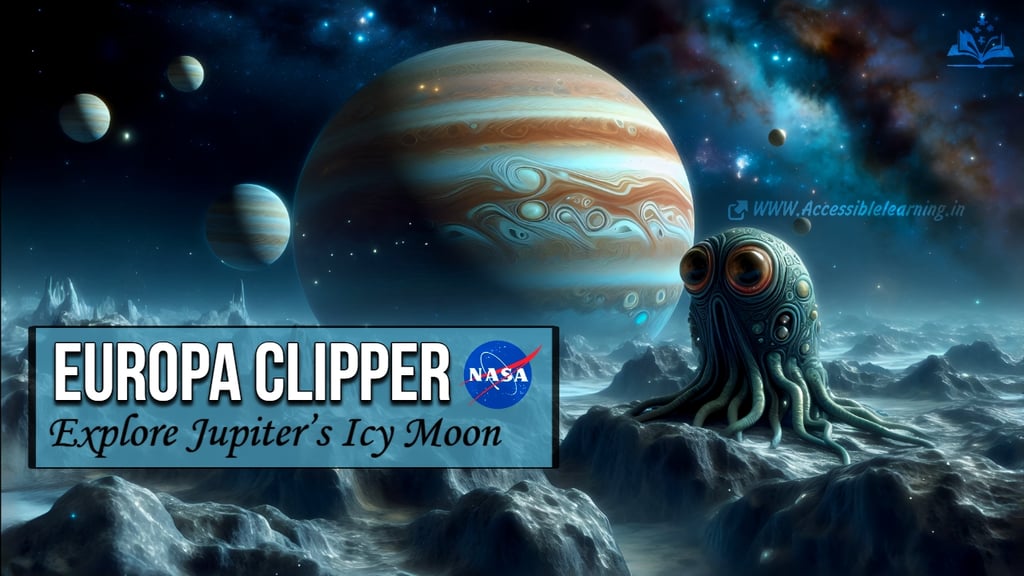
The Mysteries of Europa: NASA's Europa Clipper Mission!
Learn about NASA's upcoming Europa Clipper mission, scheduled to launch in October 2024, as it embarks on an unprecedented journey to Jupiter's moon Europa. Learn how the mission aims to uncover the mysteries of Europa's icy surface and subsurface ocean and why it is considered one of the most promising places in the solar system to find signs of life.
ISRO/NASASPACE/TECHSPACE MISSIONEDUCATION/KNOWLEDGE
Keshav Jha
9/2/20246 min read


In the ongoing quest to explore the farthest regions of our solar system, one celestial body has captured the imagination of scientists and space enthusiasts alike: Jupiter's icy moon, Europa. NASA's Europa Clipper mission, scheduled to launch on October 10, 2024, promises to unravel the mysteries of this mysterious moon, exploring the possibility that there is an ocean beneath its frozen crust that could harbor life. The mission, a blend of cutting-edge technology and visionary science, marks a significant milestone in our understanding of the universe.
The Significance of Europa!
Europa has long fascinated scientists because of its potential to support life. Despite its cold surface, Europa is thought to have a vast, salty ocean beneath its icy crust—an ocean that may contain more water than all of Earth's oceans combined. The existence of this underground ocean, kept liquid by tidal forces generated by Jupiter's immense gravity, raises serious questions about the conditions that exist there. Could life thrive in this dark, hidden ocean, isolated from the harsh environment of space?
Objectives of the Europa Clipper Mission!
The Europa Clipper mission is carefully designed to answer these questions. It is not just a trip to a distant moon but a deep dive into one of the most promising habitats for life beyond Earth. The mission has four primary objectives:
Investigating the Ice Shell and Subsurface Ocean
The mission's most important goal is to determine the thickness of Europa's ice crust and confirm the presence of an ocean beneath the surface. Using sophisticated ice-penetrating radar, Europa Clipper will probe beneath the surface, mapping the structure of the ice and looking for direct evidence of a hidden ocean.
Analyzing Surface Composition
Europa Clipper will closely examine the composition of Europa's surface, using a set of spectrometers to analyze the chemistry of the ice and any material that comes out from beneath the ocean. This will help scientists understand the chemical environment beneath the ice and assess its potential to support life.
Understanding Europa's Geology
Europa's surface is a patchwork of geological features, including ridges, cracks, and chaotic terrain—areas where ice has broken up and refrozen in complex patterns. The mission will study these features to learn the moon's geological history and the dynamic processes that shaped its surface.
Detecting and Analyzing Plumes
Previous observations have indicated the presence of plumes of water vapor emanating from Europa's surface, potentially providing a glimpse of a subsurface ocean. Europa Clipper is equipped with instruments capable of detecting and analyzing these plumes, which could provide crucial information about the ocean's composition without having to drill through the ice.


The Technological Marvels of Europa Clipper
The success of the Europa Clipper mission depends on its cutting-edge instruments, each designed to perform specific tasks that will collectively produce a comprehensive picture of Europa:
Ice-penetrating radar (REASON): This radar system will send radio waves through Europa's ice shell, allowing scientists to map subsurface layers and detect the ocean beneath. By studying the reflections of these waves, researchers can estimate the thickness of the ice and the properties of the underlying ocean.
Infrared spectrometer (MISE): This instrument will scan Europa's surface in infrared light, identifying different chemicals present in the ice. By understanding the composition of the surface, scientists can infer the chemistry of the ocean beneath.
Magnetometer (ICEMAG): The magnetometer will measure the magnetic field around Europa, providing data on the ocean's depth and salinity. Variations in the magnetic field can reveal how the ocean interacts with Jupiter's magnetic environment.
Camera and imaging systems: High-resolution cameras will capture detailed images of Europa's surface, revealing its geological features in unprecedented detail. These images will help scientists understand the moon's complex history and identify areas of interest for future exploration.
The Mission Plan: A Journey of Discovery!
Europa Clipper will not orbit Europa directly, but instead, it will orbit Jupiter, making several close flybys of the moon. This approach minimizes the spacecraft's risk of exposure to Jupiter's intense radiation, which could otherwise damage its sensitive instruments. During its mission, Europa Clipper will make about 50 flybys of Europa, each time collecting data that will take us closer to understanding this mysterious world.
The Potential for Life: What Lies Beneath!
One of the most compelling aspects of the Europa Clipper mission is its potential to answer an age-old question: are we alone in the universe? Europa's subsurface ocean, protected from the vacuum of space by miles of ice, could be a cradle for life. The conditions in this ocean, with its potential hydrothermal vents and rich chemical environment, may resemble those found in Earth's deep-sea hydrothermal ecosystems—environments where life thrives without sunlight, relying instead on chemical energy.
If life exists in Europa's ocean, it will likely be microbial, but the discovery of even the simplest organisms would be an unprecedented achievement, reshaping our understanding of the potential for life in the universe.


NASA's Europa Clipper mission is one of the most important upcoming missions in planetary exploration. Scheduled to launch in October 2024, the primary goal of this mission is to explore Jupiter's moon Europa, which is considered one of the most promising places in the solar system to search for signs of life due to its underground ocean.
Recent Developments
Spacecraft construction: So far, the Europa Clipper spacecraft is fully ready and undergoing rigorous testing. The spacecraft's huge solar arrays, which extend up to 30.5 meters, have been attached to ensure the spacecraft has enough power during its mission around Jupiter. These solar panels are necessary because, unlike solar missions closer to Earth, Jupiter's distant location requires large panels to capture enough sunlight for energy.
Testing and preparation: The spacecraft has completed key tests, including thermal vacuum testing, which simulates the extreme conditions that occur in space. Engineers are now focusing on integrating science instruments and making sure all systems are operational before launch.
Scientific goals: After arriving at Europa in 2030, Europa Clipper will conduct detailed investigations of Europa's ice shell and subsurface ocean. The mission will use a suite of scientific instruments to analyze the moon's surface, measure the thickness of its icy crust, and search for possible plumes of water vapor escaping from beneath the ice.
Future missions: The Europa Clipper mission is part of NASA's broader strategy to explore icy moons in the outer solar system. It complements the European Space Agency's (ESA) upcoming JUICE (Jupiter Icy Moons Explorer) mission, which will explore Europa and other moons such as Ganymede and Callisto.
NASA's current activities also include preparations for the Artemis program, which aims to return humans to the Moon, as well as ongoing research in areas such as climate change, space technology, and Mars exploration.
These recent updates reflect NASA's ongoing commitment to pushing the boundaries of space exploration, particularly in the search for life beyond Earth.
For more detailed updates on the Europa Clipper mission, you can check out NASA's official site and related space exploration portals.
The Europa Clipper mission is more than just a scientific endeavor; it is a testament to humanity's persistent curiosity and desire to explore the unknown. By investigating Europa, we are seeking answers not just about a distant moon but also about the fundamental nature of life. The mission's findings could have profound implications for the search for extraterrestrial life, informing future missions that could one day land on Europa or even penetrate its icy shell to directly explore its ocean.
As we stand on the cusp of this historic mission, the excitement is palpable. Europa Clipper represents the next chapter in our exploration of the solar system, a chapter that could bring us closer than ever to answering one of the most profound questions: Are we alone in the universe?


Subscribe To Our Newsletter
All © Copyright reserved by Accessible-Learning Hub
| Terms & Conditions
Knowledge is power. Learn with Us. 📚


